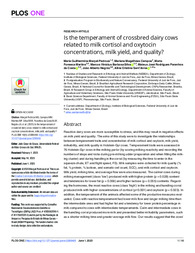Is the temperament of crossbred dairy cows related to milk cortisol and oxytocin concentrations, milk yield, and quality?
Is the temperament of crossbred dairy cows related to milk cortisol and oxytocin concentrations, milk yield, and quality?
Author(s): MARÇAL-PEDROZA, M. G.; CAMPOS, M. M.; MARTINS, M. F.; SILVA, M. V. G. B.; COSTA, M. J. R. P. da; NEGRÃO, J. A.; SANT'ANNA, A. C.
Summary: Reactive dairy cows are more susceptible to stress, and this may result in negative effects on milk yield and quality. The aims of this study were to investigate the relationships between temperament traits and concentration of milk cortisol and oxytocin, milk yield, milkability, and milk quality in Holstein-Gyr cows. Temperament traits were assessed in 76 Holstein-Gyr cows in the milking parlor (by scoring milking reactivity and recording the numbers of steps and kicks during pre-milking udder preparation and when fitting the milking cluster) and during handling in the corral (by measuring the time to enter in the squeeze chute, ET and flight speed, FS). Milk samples were collected for milk quality (% fat, % protein, % lactose, and somatic cell count, SCC), and milk cortisol and oxytocin. Milk yield, milking time, and average flow were also measured. The calmer cows during milking management (class ?low?) produced milk with higher protein (p = 0.028) content and tendencies for lower fat (p = 0.056) and higher lactose (p = 0.055) contents. Regarding the hormones, the most reactive cows (class ?high?) in the milking and handling corral produced milk with higher concentrations of cortisol (p<0.001) and oxytocin (p = 0.023). In addition, the temperament of the animals affected some of the productive measures evaluated. Cows with reactive temperament had lower milk flow and longer milking time than the intermediate ones and had higher fat and a tendency for lower protein percentage in milk compared to cows with intermediate temperaments. Calm and intermediate cows in the handling corral produced more milk and presented better milkability parameters, such as a shorter milking time and greater average milk flow. Our results suggest that the cows behavioral reactivity can be related to the intensity of their response to stress during handling.
Publication year: 2023
Types of publication: Journal article
Unit: Embrapa Dairy Cattle
Keywords: Cortisol, Gado Leiteiro, Ocitocina, Produção Leiteira, Qualidade
Observation
Some of Embrapa's publications are published as ePub files. To read them, use or download one of the following free software options to your computer or mobile device. Android: Google Play Books; IOS: iBooks; Windows and Linux: Calibre.
Access other publications
Access the Agricultural Research Database (BDPA) to consult Embrapa's full library collection and records.
Visit Embrapa Bookstore to purchase books and other publications sold by Embrapa.

